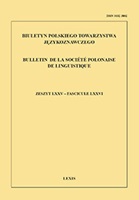Znak językowy i dychotomia significans : significatum a morfosemantem i funkcja morfosemantyczna
Linguistic sign and the dichotomy significans : significatum in relation to morphosemanteme and the morphosemantic function
Author(s): KAZIMIERZ A. SROKASubject(s): Semiotics / Semiology, Morphology, Semantics, Descriptive linguistics
Published by: Polskie Towarzystwo Językoznawcze
Keywords: F. de Saussure; L. Zawadowski; element of text; linguistic sign; signifying element (significans); signified element (significatum); morphosemanteme; form; signification; location; morphosemantic func
Summary/Abstract: The paper deals with the theory of linguistic sign and with the distinction between the elements: signifying/signifier (significans) and signified (significatum). The discussion focuses on two opposite theories: one – bilateral and psychologistic (mentalistic) ‒ coming from Ferdinand de Saussure (CLG) and the other ‒ unilateral and objectivistic ‒ authored by Leon Zawadowski (LTJ). The present author compares and evaluates these theories, juxtaposing them with his own conception of morphosemanteme and the morphosemantic function, proposed in his earlier studies (e.g. Sroka 2016a and 2016b). According to de Saussure, a linguistic sign (Fr. signe) consists of the acoustic image (Fr. image acoustique) as the signifying element (Fr. signifiant) and of the concept (Fr. concept) as the signified element (Fr. signifié). According to Zawadowski, the sign includes only the textual element (as a physical phenomenon) in its inherent features, which belongs to the plane of the signifying element, and outside of the sign there is the element of the extratextual reality as the signified element. The concept of the morphosemanteme is a generalization, modification and development of de Saussure’s and Zawadowski’s concepts of the linguistic sign. The morphosemanteme is an element of text defined according to three categories, namely: form (F) (textual segment in its inherent features), active signification (S) (the fact that a textual segment represents a given element of the extrasegmental reality), and location (L) (occurrence of a textual segment in a given environment). The morphosemantic function (of the directions: signification/location => form; form/location => signification; and form/signification => location) expands over a structurally homogeneous set of morphosemantemes. The proposed concept of the morphosemanteme as a counterpart of the language sign is neither fully bilateral, since the signified element (represented element of the extrasegmental reality (RR)) is not part of the morphosemanteme, nor fully unilateral, since in its essence the morphosemanteme includes not only form (F), i.e. the category whose values are sets of the inherent features of the textual segment, but also relational categories: active signification (S) and location (L). The conception of the morphosemanteme and morphosemantic function described here is objectivistic but it is also possible to create its psychologistic (mentalistic) interpretation, assuming that the object of cognition has its reflection (representation) in the mind of the conceiving subject.
Journal: Biuletyn Polskiego Towarzystwa Językoznawczego
- Issue Year: LXXVI/2020
- Issue No: 76
- Page Range: 307-320
- Page Count: 14
- Language: Polish

